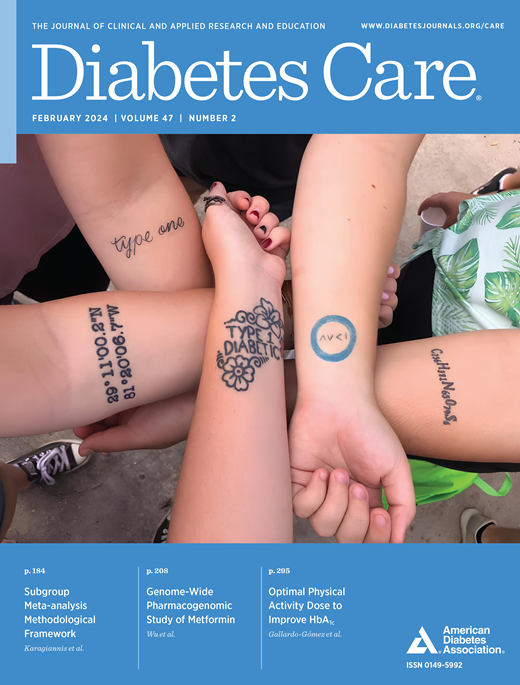在患有 1 型糖尿病和低血糖症的老年人中采用老年医学原则进行连续血糖监测:随机对照试验
IF 16.6
1区 医学
Q1 ENDOCRINOLOGY & METABOLISM
引用次数: 0
摘要
目的 对患有 1 型糖尿病(T1D)的老年人使用连续血糖监测仪(CGM)已显示出其益处。然而,CGM 的使用,加上简化的治疗方案和个性化的血糖目标更适合患有多种并发症和低血糖的老年患者,其影响尚不清楚。研究设计和方法 将患有 T1D 并伴有低血糖(两周内发生两次或两次以上低血糖[血糖<70 mg/dL,持续时间≥20 分钟])、CGM 初学者或 CGM 使用者的老年人(≥65 岁)随机分为干预组和对照组。干预措施包括在 6 个月内结合使用 CGM 和老年医学原则(即根据总体健康状况调整目标,并根据 CGM 模式和临床特征简化治疗方案)。对照组接受内分泌科医生的常规治疗。主要终点为从基线到 6 个月期间血糖为 <70 mg/dL 的时间变化。成本效益从医疗保健部门的角度进行计算。结果 我们将 131 名参与者(年龄为 71 ± 5 岁;21% ≥ 75 岁)随机分为干预组(n = 68;CGM 用户 = 33)或对照组(n = 63;CGM 用户 = 40)。从基线到 6 个月期间,干预组低血糖的中位数变化为-2-6%,对照组为-0.3%(中位数差异为-2.3% [95% CI -3.7%, -1.3%]; P < 0.001)。这一改善在 CGM 初学者(-2.8%;95% CI -5.6%,-0.8%)和 CGM 使用者(-1.2%;95% CI -2.7%,-0.1%)中均可见。两组的 HbA1c 没有差异(7.5% vs 7.3%)。干预具有成本效益(每质量调整生命年的增量成本效益比为 71,623 美元)。结论 对于患有 T1D 且低血糖风险较高的老年人,根据老年医学原则加强 CGM 的使用可降低低血糖风险,同时不会恶化血糖控制,具有成本效益。本文章由计算机程序翻译,如有差异,请以英文原文为准。
Continuous Glucose Monitoring With Geriatric Principles in Older Adults With Type 1 Diabetes and Hypoglycemia: A Randomized Controlled Trial
OBJECTIVE Continuous glucose monitoring (CGM) use in older adults with type 1 diabetes (T1D) has shown benefits. However, the impact of CGM use, coupled with simplified treatment regimens and personalized glycemic goals that are better suited for older patients with multiple comorbidities and hypoglycemia, is not known. RESEARCH DESIGN AND METHODS Older adults (≥65 years) with T1D with hypoglycemia (two or more episodes of hypoglycemia [blood glucose <70 mg/dL for ≥20 min over 2 weeks]) who were CGM naïve or CGM users were randomized to intervention and control groups. The intervention consisted of the combined use of CGM with geriatric principles (i.e., adjusting goals based on overall health, and simplification of regimens based on CGM patterns and clinical characteristics) over 6 months. The control group received usual care by their endocrinologist. The primary end point was change in time when blood glucose was <70 mg/dL from baseline to 6 months. Cost-effectiveness was calculated using a health care sector perspective. RESULTS We randomized 131 participants (aged 71 ± 5 years; 21% ≥75 years old) to the intervention (n = 68; CGM users = 33) or the control (n = 63; CGM users = 40) group. The median change in hypoglycemia from baseline to 6 months was −2·6% in the intervention group and −0.3% in the control group (median difference, −2.3% [95% CI −3.7%, −1.3%]; P < 0.001). This improvement was seen in both CGM naïve (−2.8%; 95% CI −5.6%, −0.8%) and CGM users (−1.2%; 95% CI −2.7%, −0.1%). The HbA1c did not differ between the groups (7.5% vs 7.3%). The intervention was cost-effective (incremental cost-effectiveness ratio $71,623 per quality adjusted life-year). CONCLUSIONS In older adults with T1D and high risk of hypoglycemia, CGM use enhanced by geriatric principles can lower hypoglycemia without worsening glycemic control in a cost-effective fashion.
求助全文
通过发布文献求助,成功后即可免费获取论文全文。
去求助
来源期刊

Diabetes Care
医学-内分泌学与代谢
CiteScore
27.80
自引率
4.90%
发文量
449
审稿时长
1 months
期刊介绍:
The journal's overarching mission can be captured by the simple word "Care," reflecting its commitment to enhancing patient well-being. Diabetes Care aims to support better patient care by addressing the comprehensive needs of healthcare professionals dedicated to managing diabetes.
Diabetes Care serves as a valuable resource for healthcare practitioners, aiming to advance knowledge, foster research, and improve diabetes management. The journal publishes original research across various categories, including Clinical Care, Education, Nutrition, Psychosocial Research, Epidemiology, Health Services Research, Emerging Treatments and Technologies, Pathophysiology, Complications, and Cardiovascular and Metabolic Risk. Additionally, Diabetes Care features ADA statements, consensus reports, review articles, letters to the editor, and health/medical news, appealing to a diverse audience of physicians, researchers, psychologists, educators, and other healthcare professionals.
 求助内容:
求助内容: 应助结果提醒方式:
应助结果提醒方式:


